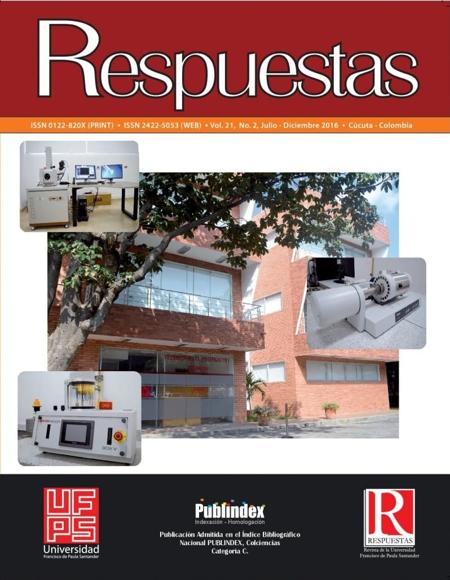Perfil de súper-corrientes en una lámina de Al a campo magnético cero
Super-current profile in an Al flat at zero magnetic field
Contenido principal del artículo
Objetivo: En este artículo se presentan resultados numéricos de simulaciones computacionales del perfil de supercorrientes en una placa superconductora de aluminio a baja temperatura, visando a ser analizados para la fabricación de nanoestructuras para posibles aplicaciones en dispositivos nano-electrónicos. Metodología: Se solucionan las ecuaciones dependientes del tiempo Ginzburg-Landau con el popular método de variables de enlace para una película de Aluminio con una corriente directa aplica y en ausencia de campo magnético aplicado. Resultados: Pares de vórtices cinemáticos emergen de la parte central de la muestra con su posterior aniquilación en un valor determinado de la corriente. La nucleación periódica de los vórtices cinemáticos conduce a la aparición de oscilaciones temporales del voltaje. Hacia corrientes altas el estado superconductor es destruido y la muestra se comporta como un metal óhmico. Hacia corrientes bajas una pequeña resistencia aparece debida a los contactos metálicos donde la corriente es aplicada. Conclusión: La aparición de pares vórtices-anti-vórtices destruye el estado superconductor en la parte media de la lámina. Su naturaleza es determinada por el perfil de supercorriente dentrode la muestra. Vórtices cinemáticos muestran una geometría alongada ocasionando un aumento drástico en la resistencia local del material.
Descargas
Detalles del artículo
J. Van de Vondel, C. C. de Souza, B. Y. Zhu, et al. “Vortex Rectification Effects in Films with Periodic Asymmetric Pinning”, Phys. Rev. Lett., vol. 94, no. 5, pp. 057003, 2005.
K. Yu, T. W. Heitmann, C. Song, et al. “Asymmetric weak-pinning superconducting channels: Vortex ratchets”, Phys. Rev. B, vol. 76, no. 22, pp. 220507, 2007.
K. Yu, M. B. S. Hesselberth, P. H. Kes and B. L. T. Plourde. “Vortex dynamics in superconducting channels with periodic constrictions”, Phys. Rev. B, vol 81, pp. 184503, 2010.
M. B. Hastings, C. J. O. Reichhardt and C. Reichhardt. “Ratchet Cellular Automata”, Phys. Rev. Lett., vol 90, no. 24, pp. 247004, 2003.
T. Puig, E. Rosseel, M. Baert, et al. “Stable vortex configurations in superconducting 2×2 antidot clusters”, Appl. Phys. Lett., vol 70, pp. 3155, 1997.
G. Karapetrov, V. Yefremenko, G. Mihajlovic, et al. “Evidence of vortex jamming in Abrikosov vortex flux flow regime”, Phys. Rev. B, vol. 86, no. 5, pp. 054524, 2012.
G. Berdiyorov, K. Harrabi, F. Oktasendra, et al. “Dynamics of current-driven phase-slip centers in superconducting strips”, Phys.Rev. B, vol. 90, no. 5, pp. 054506, 2014.
F. Rogeri, R. Zadorosny, P. N. LisboaFilho, et al. “Magnetic field profile of a mesoscopic SQUID-shaped superconducting film”, Supercond. Sci. Technol., vol. 26, no. 7, pp. 075005, 2013.
R. I. Rey, A. R. Alvarez, C. Carballeira, et al. “Measurements of the superconducting fluctuations in optimally doped BaFe2 −xNixAs2 under high magnetic fields: probing the 3D-anisotropic Ginzburg–Landau approach”, Supercond. Sci. Technol., vol. 27, no. 7, pp. 07500, 2014.
P. J. Pereira, V. V. Moshchalkov and L. F. Chibotaru. “Efficient solution of 3D Ginzburg-Landau problem for mesoscopic superconductors”. J. Phys. Conf. Ser., vol. 490, pp. 012220, 2014.
J. I. Martin. “Flux Pinning in a Superconductor by an Array of Submicrometer Magnetic Dots”, Phys. Rev. Lett., vol. 79, no. 10, pp. 1929, 1997.
D. J. Morgan and J. B. Ketterson. “Asymmetric Flux Pinning in a Regular Array of Magnetic Dipoles”, Phys. Rev. Lett., vol. 80, no.16, pp. 3614, 1998.
M. V. Milosevic, G. R. Berdiyorov and F. M. Peeters, Phys. “Mesoscopic Field and Current Compensator Based on a Hybrid Supercond uctor-Ferromagnet Structure”, Rev. Lett., vol. 95, no. 14, pp. 147004, 2005.
G. R. Berdiyorov. “Effect of surface functionalization on the electronic transport properties of Ti3 C2MXene”, Eurp. Phys. Lett., vol. 111, no. 6, pp. 67002, 2015.
G. R. Berdiyorov, K. Harrabi, J. P. Maneval and F. M. Peeters. “Effect of pinning on the response of superconducting strips to an external pulsed current”, Supercond. Sci. Technol, vol. 28, no. 2, pp. 25004, 2015.
G. R. Berdiyorov, M. V. Milosevic, F. M. Peeters and D. Y. Vodolazov. “Kinematic vortex-antivortex lines in strongly driven superconducting stripes”, Phys. Rev. B, 79, no. 18, pp. 184506, 2009.
P. Sanchez, J. Albino Aguiar and D. Dominguez. “Behavior of the flux-flow resistivity in mesoscopic superconductors”, Physica C, vol. 503, pp. 120-122, 2014.
D. Gropp, H. G. Kaper, G. K. Leaf, et al. “Numerical simulation of vortex dynamics in type-II superconductors”, J. Comput. Phys., Vol. 123, no. 2, pp. 254-266, 1996.
C. P. Poole Jr. “Superconductivity”, 2nd, Elsevier Academic Press, The Netherlands, 2007.







